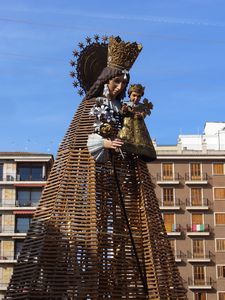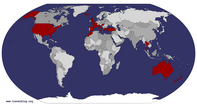Advertisement
Published: April 1st 2012

 Las Fallas Fiesta, Valencia
Las Fallas Fiesta, Valencia
Christian imagery - the wooden 'cape' was later filled with flowers...I don't think they burned her... We walked out of the train station in Valencia right into the middle of Las Fallas - the biggest fiesta in the region - which, from the four hours we were there, seemed to be about eating, (mainly paella and chocolate coated churros) drinking, spontaneous loud and fast brass band music on street corners, very loud fireworks and huge cartoon-like satirical sculptures on every available plaza.
I'd read that effigies are set alight on the last day of the week long fiesta - but these giant tableaux were so artfully and professionally constructed - surely they wouldn't meet a firey destruction days after they were errected?
We found out through the local TV channel that this was the case - we watched (without understanding a word of the commentary of course) as dozens of Disney-styled 3D sculpture cartoons up to 30 metres high melted in conflagrations of contorted gruesomeness while the cameras panned in on sobbing children dressed in imaculate national costume watching the ritual with their gleeful families. Very strange.
Google: Las Fallas Valencia.
We weren't staying in Valencia as acommodation during Las Fallas is exorbitant. On the net I'd

 Old walls of Valencia
Old walls of Valencia
Torres de Sorranos, 14th century medieval city gatewayseen a village in the hills an hour inland - a classic Spanish village of white washed stone houses tumbling down a hillside, with sheer cliffs behind and the walls of a ruined castle completing the picture. The apartment had a balcony with views of the village and if it was only half as good as the pic on the net, it would be pretty special.
The only way to get to beautiful Chulilla was by bus from Valencia at 6.30pm, arriving after 8pm. No problem we thought - the Spanish don't even think of going out for dinner till 8, so good timing to get to one of Chulilla's 7 restaurants. It may have only 800 residents, but Chulilla is a popular day or weekend spot, particularly with walkers and rock climbers attracted by the sheer escarpments along the river valley.
But this was Thursday. Before the tourist season. Plaza de Baronia de Chulilla was quiet and dark as we got off the bus, only one bar open and that didn't serve food. Welcome to the variable ways of Spanish eating establishments.
The incredible view from our balcony in the

 Fallas under construction
Fallas under construction
one of the less religious imagesmorning more than made up for the night before, (we'd been met by the owner's aunt who, like everyone in the village, had not a singe word of English and sometimes travelling means just a glass of vino tinto for tea).
Chulilla is so stunning it's not only as beautiful as it looks in photos - it's better! Our apartment looks directly out to the escarpment so we can watch the rock climbers and the 180' view of the village, church, castle and gorge is too much to take in with a couple of photos.
The village dates from 1274 and as you walk up and down the maze of alleys that zig-zag up the sloping side of the cliff, you're not sure if you're walking along a road or into someone's back porch. Everywhere you look is a photograph. The castle has pre-Roman and Islamic remains as well as medieval - and no wonder - the cliff walls form a natural fortification with views for miles up and down the curves of the river gorge.
Many of the houses are now weekend getaways for Valencians, but there are enough locals

 Beautiful Chulilla
Beautiful Chulilla
with the ruined castle walls echoing the rock walls of the gorgehere to give the impression that life has changed little for them in the last 700 years. We get a resigned "Buenos dias" mumbled back when we greet them with our ubiquitous "hola!" and we can tell they are wondering why on earth we are here. Apart from a couple of climbing groups at the weekend we are the only tourists.
Chulilla is a different Spain from Madrid and Barcelona. There are one or two concessions to modern living - slices of medieval walls have been carved away to acomodate cars. Visitors have to park at either end of the village and ingenious is the word for residents' parking - the few cars are well dented and you could only slip a piece of paper between number plates and the wall up sloping alleys.
We've walked along cliffs and through caves, picked wild rosemary for our pork chops bought in one of two tiny but perfectly formed butchers. We've bought various pastries off a sough-dough faced Mrs Bun the Baker. What we thought were savoury, were apple, then what we thought was apple was ham + cheese, but they were all delicious. Spaniards love

 Chulilla
Chulilla
every corner of the village was a picture postcardbread and pastry, but pastry is tricky as you're never quite sure what's in it.
A warning for anyone gluten intolerant - cross Spain off your travel list!
And we found what you read about in travel stories but expect doesn't really exist - a gorgeous little restaurant stuck in the middle of a picturesque village where they prepare fresh local specialities with gormet flair, acompanied by exceptional local wines, all at village cafe prices.
Fortunately the daughter was waiting at tables that day (while waiting for a real job to use her tele-communications degree) so could explain the menu, which had no English translations at all. We might have missed ordering the quail salad with walnuts and capers or the pork ribs with honey or the little sausages with tiny mushrooms laced with a village made muscat.
We went for lunch as it was Sunday and were relatively sure it would be open - although there seems no rhyme nor reason to restaurant opening hours here. We wandered up at 1.30ish but were told in no uncertain terms to wait till 1.45 when it officially opened. And

 Balcony view at la Muela
Balcony view at la Muela
perfect for a sunset vino tintowe thought it would be closed on Monday - but this Monday is St Jacob's day so restaurants will be open, but the chemist etc will be closed.
Then on Tuesday everything seemed to be closed - we walked down to the square at lunchtime and not a soul was around, not even a village cat, shutters all down. Rhys had a cold and needed drugs. I'd tried to translate the small sign in the chemist window, which seemed to say it was only open "mañana", but also had 'vespers' hours.
On the off-chance I went down the now cold and dark street after 7pm. Lights were on in the square. Shops were open, people were out and about shopping, old ladies, children. The 'farmacia' was thankfully also open, so all it took now was a bit of miming - nose-blowing and throat grabbing - and a magic global word 'paracetamol'! and we were sorted.
A Spanish village clearly moves to its own rhythms - and as it's been here since the 13th century, it has every right to.
To get to the Costa del Sol, we had

 Morning view
Morning view
first sunlight on the village churchto catch a bus from Chulilla and a train back to Madrid to connect with a train to Malaga, but it gave us a chance to see parts of the country we wouldn't see by coast hopping. It wasn't as depressingly drab as Madrid to Barcelona, with Valencia obviously being a fertile agricultural area, but the middle of Spain does appear to be mainly rocks and olive trees. Lots and lots of olive trees.
Two days in Malaga doesn't sound much but it was enough to see the sights in this very compact coastal city - another enchanting old city area full of tapas bars and conveniently close together historical sites. We wouldn't get to Granada to see the much-hyped Alhambra Moorish palace, but the Alcazaba certainly gave us a taste of Islamic architecture with its cool passageways and romantic couryard gardens.
Our favourite of the historical trifecta - palace, castle and ruins - was the Roman theatre unearthed in 1951 when a garden was being dug in front of the Alcazaba. The Romans built on pagan sites, Christians built on Roman sites, the Moors built on Christian sites - in Europe you get

 Valley view from the castle
Valley view from the castle
looking towards the next two villagesthis amazing layer-cake of history.
First you walk through the 21st century interpretive centre with interactive touch screen tables, then you walk back into the 1st century, among carved pillars and paving stones walked on by actors in the age of Augustus. And it was free!
The theatre is still used today - workers were dismantling a sound system and a huge cross had been erected at the top of the stepped marble ampitheatre, probably for Easter celebrations. A pagan festival celebrated by Christians in a resurrected Roman theatre. Nice.
Now, do you know the Monty Python sketch where they slag off poms going on holiday in Spain, complaining about the food being "ever so greasy" and singing, "Torremolinos"? That's why I refused to stay there.
We drove through Torremolinos on the way to our hotel in Mijas Costa and I was right. It looked like Southend in southern Spain. Where we are is nearly as bad - "English" pubs serving sunday roasts, UK newspapers and food in the shops - it's where English retirees have colonised Spain and mock-Spanish village apartment blocks crawl for miles up the

 Downtown Chulilla
Downtown Chulilla
a view at the end of every alleywaybarren hillsides.
I've developed a theory that all 'resorts' have been built in the style of mock-Spanish villages. And it's a good job we didn't come to lie on a beach all day - the beach here could really only be described as gravel. Call that a beach? (Sorry - that's the trouble with living at Matarangi!)
But we've done a cool thing and met up with friends we made while caravanning round Australia. Pat and Ann were going round Oz in a van the size of our van's ensuite and we drank vast quantities of wine and mocked Aussies together. They've now joined the throng of ex-pat English living in southern Spain for the climate, to escape political-correctness-gone-mad UK and for the cheap fags.
In the next instalment...Pat and Ann show us Gibraltar and - like Websters Dictionary - we're Morocco Bound!
Advertisement
Tot: 0.152s; Tpl: 0.013s; cc: 12; qc: 58; dbt: 0.0631s; 1; m:domysql w:travelblog (10.17.0.13); sld: 1;
; mem: 1.2mb






















